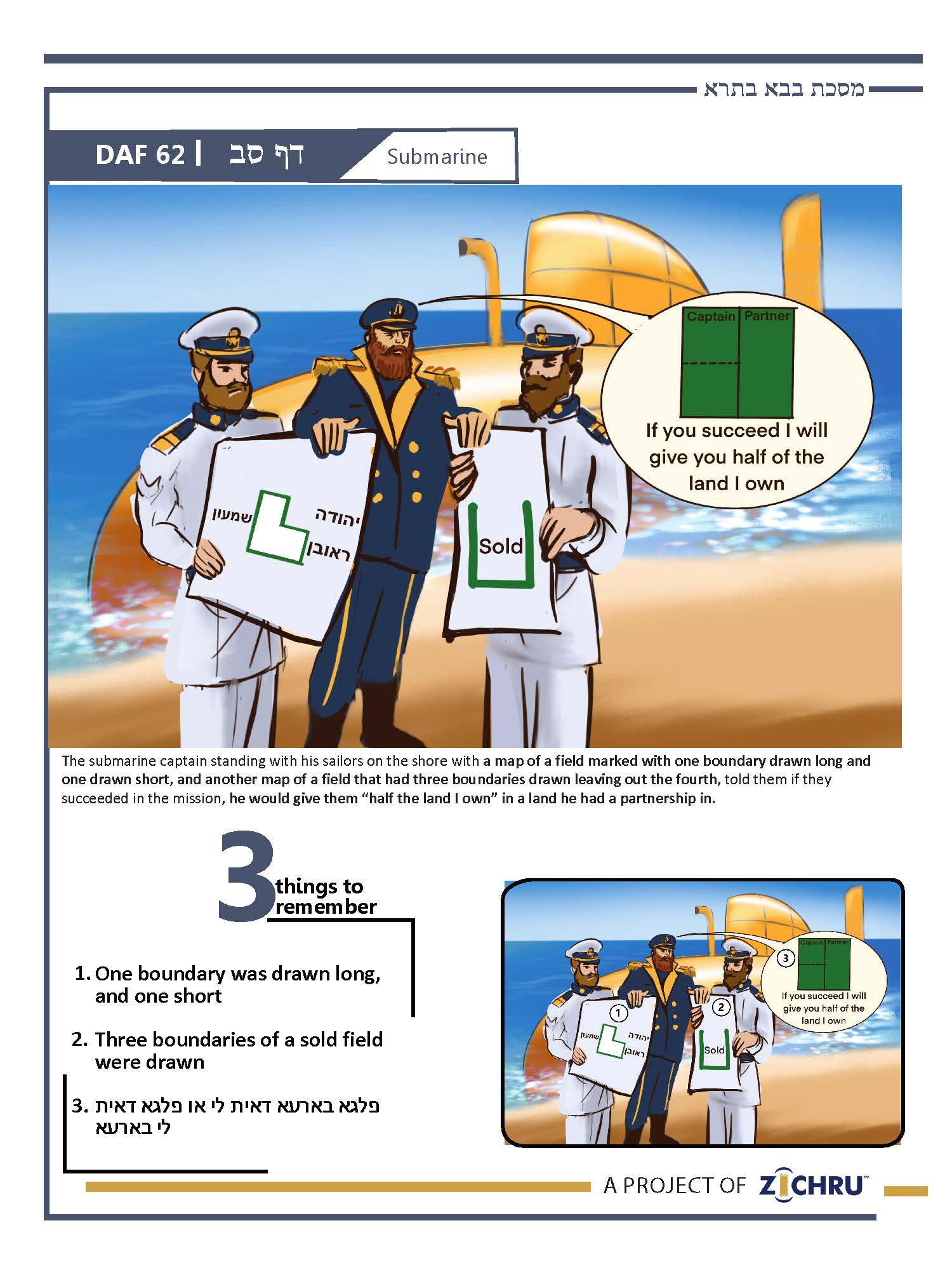Bava Basra - Daf 62
- Audio Timestamps
0:00 - The 3 Sugyos
2:55 - Review of 3 Sugyos
5:42- Siman
8:19 - 4 Blatt Back Chazarah
14:25 - Pop Quiz (Last 7 blatt)
For access to all Zichru resources including PDFs, and illustrations CLICK HERE
- One boundary was drawn long, and one short
The Gemara says: מצר לו מצר אחד ארוך ומצר אחד קצר – If [the seller] drew one boundary long, and one boundary short, e.g., he drew the entire length of the western boundary (where the adjacent field belonged to one person), and only half of the eastern boundary (of which half the adjacent field belonged to one person, and half to another), Rav says: לא קנה אלא כנגד הקצר – he only acquires the area which is opposite the short [boundary], i.e., the half of the field enclosed by both described boundaries. Rav Kahana and Rav Assi asked: ויקנה כנגד ראש תור – but let him acquire the area parallel to the ends of the boundaries, i.e., inside a diagonal line drawn from the long boundary to the short boundary!? Rav was silent, and the Rashbam explains he accepted their position. The Gemara concludes that Rav agreed (even before retracting) that if the fields on the eastern side belong (for example) to Reuven and Shimon, respectively, and on the western side to Levi and Yehudah, respectively, and he drew the eastern boundary with Reuven and Shimon’s fields, and the western side with only Yehudah’s field, that he acquires inside the diagonal line from the ends of the two boundaries.
- Three boundaries of a sold field were drawn
Amoraim discuss a case where three boundaries of a sold field were drawn, but the fourth boundary was not. Rav says: קנה הכל חוץ ממצר רביעי – he acquires everything except for a furrow’s width of the fourth boundary, which the seller retains. Shmuel says he even acquires the fourth boundary, because it did not need bear mentioning. Rav Assi says: לא קנה אלא תלם אחד על פני כולה – he only acquires a single furrow’s width around the entire [field], along the three drawn boundaries. He holds like Rav, that the seller left out the fourth boundary to retain it but adds that he retained everything along with it except for the bare minimum possible for the sale. Rava rules like Rav but adds that the seller only retains the boundary if it is not מבלע – contained inside the other boundaries, and additionally has either a row of palm trees, or is large enough to plant nine kavs of seed (making it independently significant). In another version, Rava said that if the boundary either is outside the other boundaries or has the distinction of a row of palms or potential for planting nine kavs, it is not sold with the field.
- פלגא דאית לי בארעא vs. פלגא בארעא דאית לי
Rabbah said that if a partner of a field wrote in a שטר of sale: פלגא דאית לי בארעא – I am selling “half that I own in the land,” פלגא – then half the land is sold (i.e., the partner’s entire portion). If he wrote: פלגא בארעא דאית לי – “half in the land that I own,” ריבעא – then a quarter of the total land is sold (i.e., half the partner’s portion). In the first case, he sold the half which he owns, whereas in the second case, he sold half of the land which he owns, and thus sold a quarter of the land. Abaye asked Rabbah that there should be no difference between the cases, and even the second case should be interpreted to mean he is selling his entire half-portion (i.e., selling a full “half of the land,” that half “which he owns”). Rabbah was silent, which Abaye took to mean that Rabbah accepted Abaye’s argument. However, Abaye discovered שטרות written in Rabbah’s Beis Din which were consistent with his original ruling.
Siman – Submarine
The submarine captain standing with his sailors on the shore with a map of a field marked with one boundary drawn long and one drawn short, and another map of a field that had three boundaries drawn leaving out the fourth, told them if they succeeded in the mission, he would give them “half the land I own” in a land he had a partnership in.


